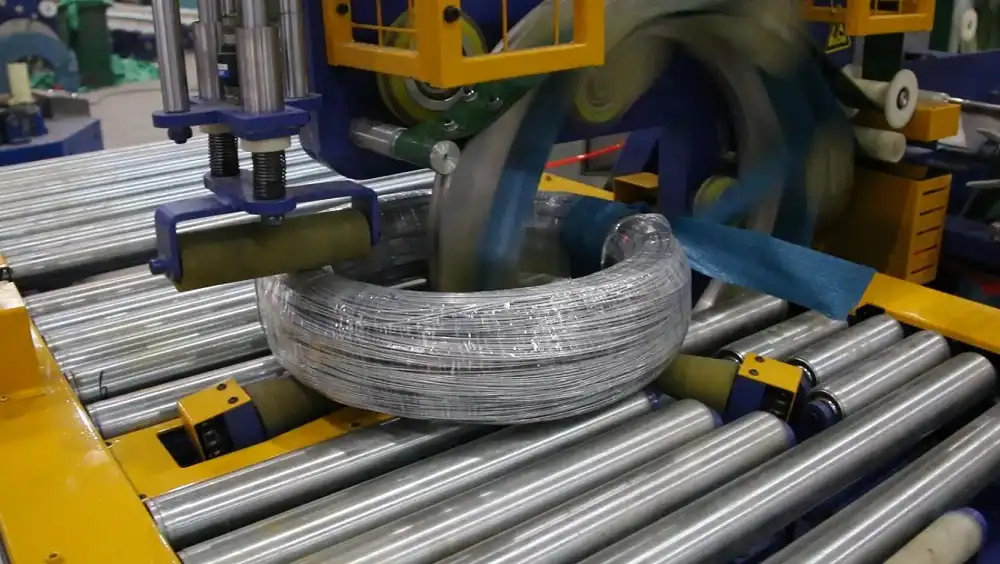wire coil compacting and handling system
Optimizing Wire Coil Handling: A Look at Automated Compacting and Strapping Systems
Efficiently managing large wire coils is a critical aspect of operations in metal processing and fabrication. Manual handling presents challenges related to safety, consistency, and speed. Automated wire coil compacting and handling systems offer a robust solution, streamlining the process from initial coil reception to final dispatch-ready packaging. This overview explores the typical components and benefits of such systems.
More information for wire coil compactor details can be explored here.
Key Stages in Automated Wire Coil Handling
A comprehensive automated system integrates several key stations and processes to ensure smooth, efficient coil management.
Reform Station
The process typically begins at the Reform Station. Here, incoming wire coils are received and correctly oriented. Often, coils are carefully placed directly onto a transport pallet via a controlled downward transfer mechanism, preparing them for movement through the system.
Pallet Conveyor Line
The backbone of the system is the Pallet Conveyor Line, responsible for transporting the coils between various processing stations. The design of this conveyor is crucial and must be tailored based on:
- Capacity: The required throughput or number of coils processed per hour.
- Station Layout: The number and type of workstations integrated into the line.
- Coil Specifications: The maximum weight and dimensions of the coils being handled.
- Buffering Needs: Requirements for temporary storage or accumulation within the line.
Trimming Station
Depending on the specific application requirements, a Trimming Station can be incorporated. This station precisely cuts the leading and trailing wire ends (wraps) of the coil. In some system configurations, this trimming process can occur while the coil remains in a vertical orientation.
Coil Compactor (e.g., PCV-P Type)
The heart of the packaging process is the Coil Compactor. This unit applies significant force to densify the wire coil, creating a tighter, more stable package that is easier and safer to handle, store, and transport. Vertical compactors, such as the PCV-P type referenced, are designed to accommodate a range of coil heights. Compacting stations are typically integrated directly with automated strapping or wire binding units.

Strapping / Binding Unit
Immediately following compaction, the densified coil must be secured. Automated binding units apply either high-tensile steel or plastic strapping, or robust wire ties, around the coil circumference at predetermined points. This ensures the coil maintains its compacted form.
Weighing Station and Tag Marking
Accurate data capture is essential. An integrated Weighing Station precisely measures the weight of the final compacted and strapped coil. Following this, a Tag Marking system automatically applies identification labels. These labels can include weight, dimensions, material grade, tracking barcodes, and other customer-specific information.
 automatic steel wire coil packing machine
automatic steel wire coil packing machine
Unloading Station
Once compacted, strapped, weighed, and tagged, the finished coil pallet is moved off the main line at the Unloading Station. The design of this station varies based on downstream logistics and storage strategies. Common options include:
- Storing Racks: Simple offload points for forklift removal.
- Walking Beam Conveyors: Automated transfer to adjacent storage or shipping lines.
- Storage Vehicles: Automated guided vehicles (AGVs) or rail-guided carts for transport to warehouse locations.
Electrical Control System and Monitoring
The entire automated handling and packaging line operates under a unified Electrical Control System, typically orchestrated by a Programmable Logic Controller (PLC). Sophisticated systems include comprehensive coil tracking capabilities, often utilizing hook identification readers or other sensors linked directly to the plant's manufacturing execution system (MES) or enterprise resource planning (ERP) system. This allows for real-time monitoring, data logging, and seamless integration with overall plant operations.
Hydraulic System
For components requiring high force and precise control, such as the coil compactor or certain heavy-duty transfer mechanisms, hydraulic actuation is often the preferred choice. These movements are powered by a dedicated central Hydraulic Power Unit, providing reliable and consistent force.
 automatic steel wire coil packing machine
automatic steel wire coil packing machine
Advantages of Automated Wire Coil Compacting and Strapping Systems
Implementing automation in wire coil handling yields substantial operational benefits:
- Reduced Investment (Relative to Complexity): Streamlined designs, like direct coil placement onto pallets at the reform station, can optimize initial costs.
- Lower Maintenance: Simple, robust mechanical designs, such as belt-driven conveyors and direct shaft-driven motors, minimize wear points and simplify maintenance routines.
- Scalability: Standardized, modular conveyor sections and station designs facilitate easier system expansion or reconfiguration as production needs evolve.
- Accessibility: Compactor and binding units are typically designed with maintenance access in mind for vital components.
- Improved Operator Visibility: Centralized control stations often provide an open view of the entire line, simplifying monitoring and operation.
- Reduced Noise Levels: Design choices like belt drives for conveyor sections contribute to a quieter working environment compared to older chain-driven systems.
- Optimized Floor Space: An integrated, automated line generally requires a more compact footprint compared to the space needed for equivalent manual operations and staging areas.
- Enhanced Safety: Significantly reduces manual lifting and handling of heavy, potentially unstable coils, minimizing ergonomic risks and potential injuries.
- Increased Throughput & Consistency: Automation ensures repeatable cycle times and consistent package quality, boosting overall productivity.
Automated wire coil compacting and handling systems are a valuable investment for facilities seeking to improve efficiency, enhance workplace safety, and ensure the consistent quality of their finished products.
